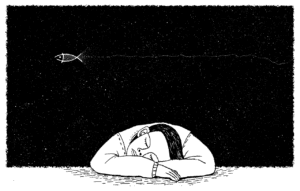Narcolepsy (and Cataplexy)
What is narcolepsy?
Narcolepsy and excessive daytime sleepiness (EDS) are caused by a neurological disorder that prevents the brain from regulating a person’s sleep-wake cycle. This condition is different from idiopathic hypersomnia. People who have narcolepsy can fall instantly asleep for a few moments, or a few minutes. Some even stay asleep longer and can experience hallucinations while asleep or upon waking. Not all people with narcolepsy experience cataplexy, or the sudden loss of muscle control, but many do. Most people are not diagnosed until years after the onset of symptoms.
What is cataplexy?
Cataplexy is a unique symptom of narcolepsy that is characterized by sudden and uncontrollable muscle weakness or paralysis that is generally triggered by a strong emotion, such as excitement, fear, anger, or laughter. Cataplexy by itself is often misdiagnosed as a seizure disorder. Cataplectic attacks vary in severity from slight momentary drooping of the eyelids to inability to remain standing.
What are the symptoms of cataplexy?
A person experiencing a cataplectic attack usually is awake and aware of what is happening, but he/she cannot move. These episodes last up to a few minutes, and some people may fall asleep afterwards. The frequency of cataplectic episodes varies widely among people with narcolepsy.
What causes cataplexy?
Laughter is reported as the most common stimulus for cataplexy. The loss of muscle tone in cataplexy occurs because of the inability to regulate sleep states. During normal rapid eye movement (REM) sleep, there is a natural loss of muscle tone. However, in the case of cataplexy, that characteristic of REM sleep occurs suddenly during the day, causing weakness or full paralysis. This is all ultimately caused by an autoimmune destruction of the neurotransmitter hypocretin, which regulates arousal and wakefulness.
How is narcolepsy treated?
The U.S. Food and Drug Administration approved a drug called Modafinil for the treatment of EDS in 1999. In addition, two classes of antidepressant drugs have been proven to help control cataplexy. Many people with narcolepsy and EDS take regularly scheduled naps, and avoid drinking alcohol or caffeinated beverages before bed. Another drug that is widely used to treat narcolepsy is Xyrem® (sodium oxybate or gamma hydroxybutyrate, also known as GHB), a short-acting sleep aid that is tightly regulated because it has potential for abuse. Xyrem was approved in 2002 by the FDA.
How is cataplexy treated?
Sodium oxybate and gamma-hydroxybutyrate are effective treatment options to reduce the number of cataplexy episodes.
Where can I learn more about narcolepsy/cataplexy?

Narcolepsy (and Cataplexy) Articles

The Origin of Black Noir’s Narcolepsy in Hit TV Series ‘The Boys’

SLEEP 2024: Presented Data Highlighted Possible Benefits of ALKS 2680 for Narcolepsy Type 1

SLEEP 2024: Two Studies Explore Link Between Narcolepsy and Cardiovascular Disease Risk

Phase 2 Trial Commences for ALKS 2680, a Potential Game-Changer for Type 1 Narcolepsy



TAK-861: Takeda Plans to Begin Late-Stage Testing for Experimental Narcolepsy Treatment




